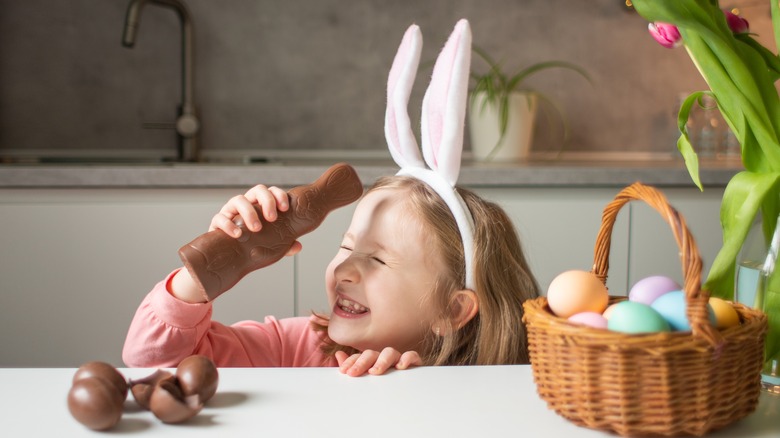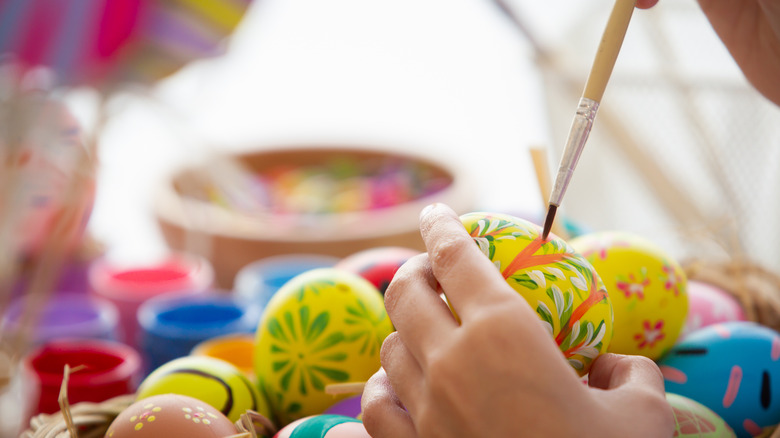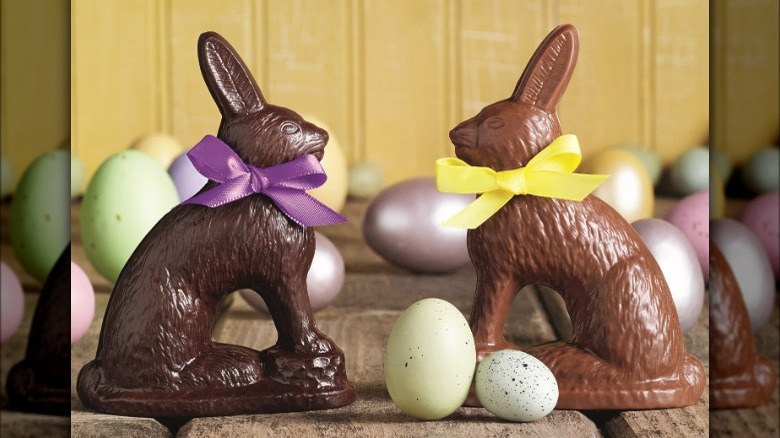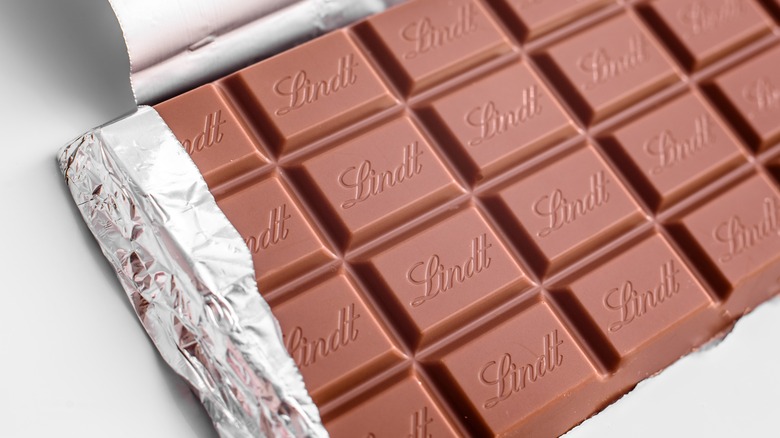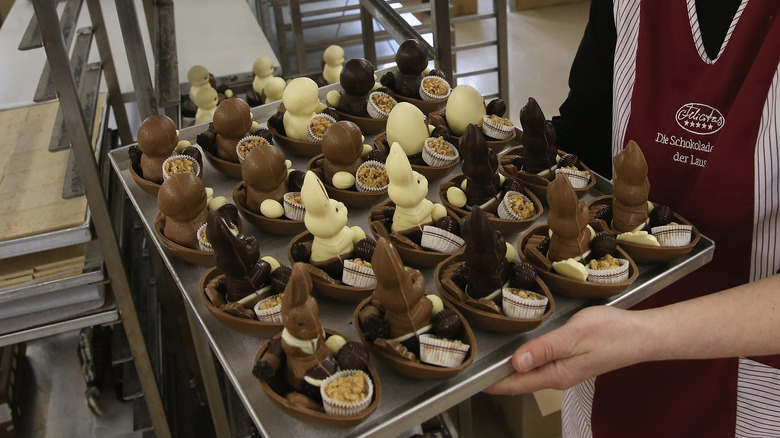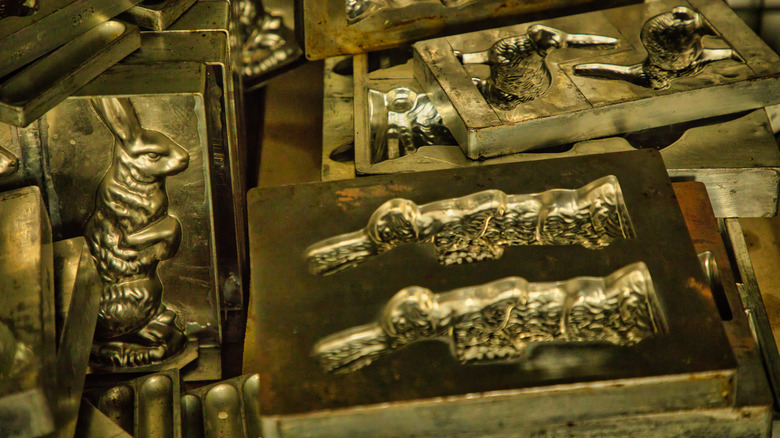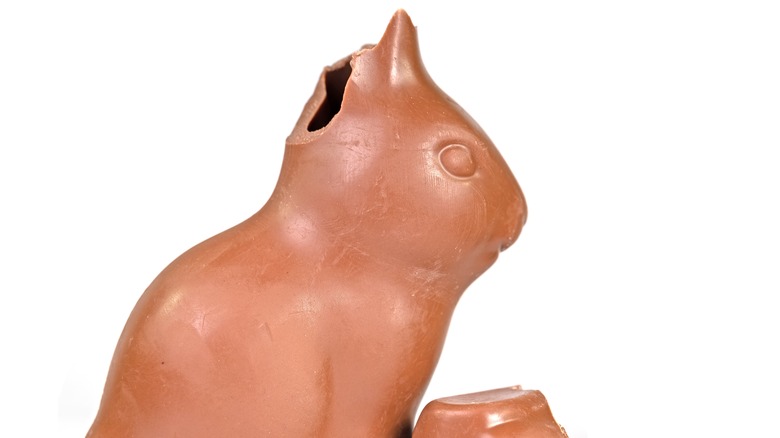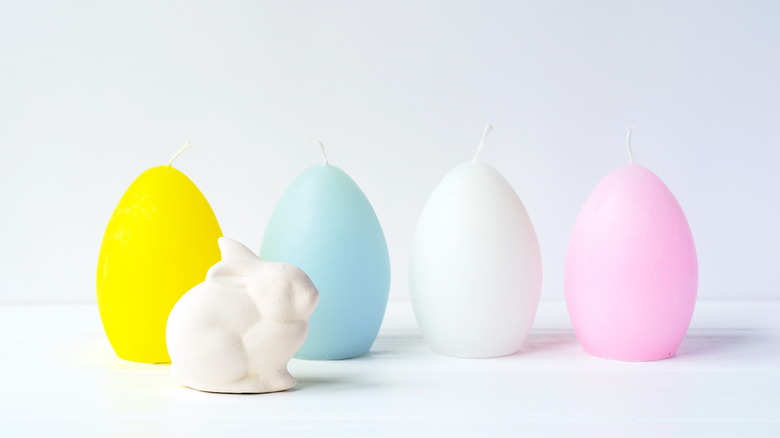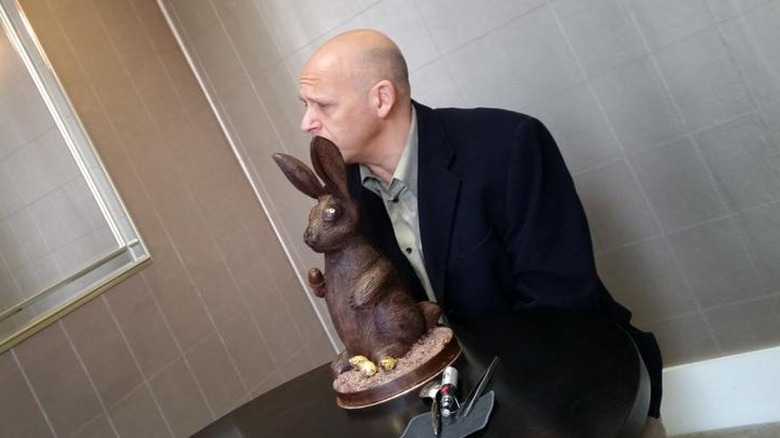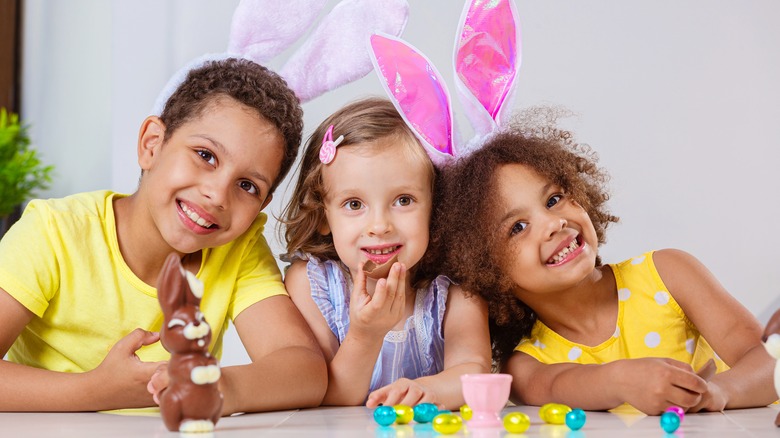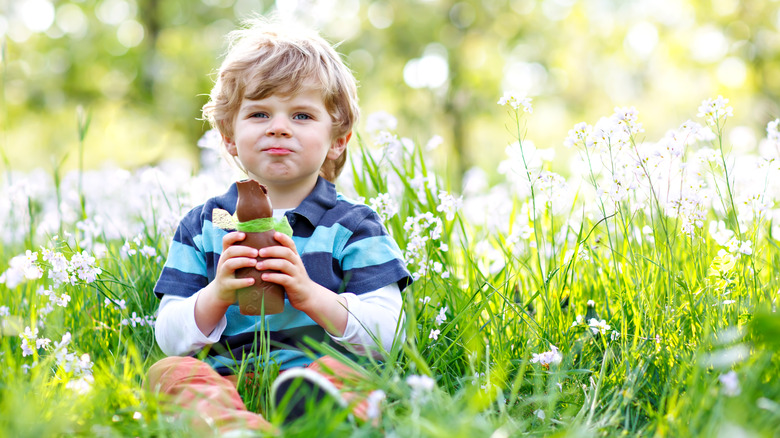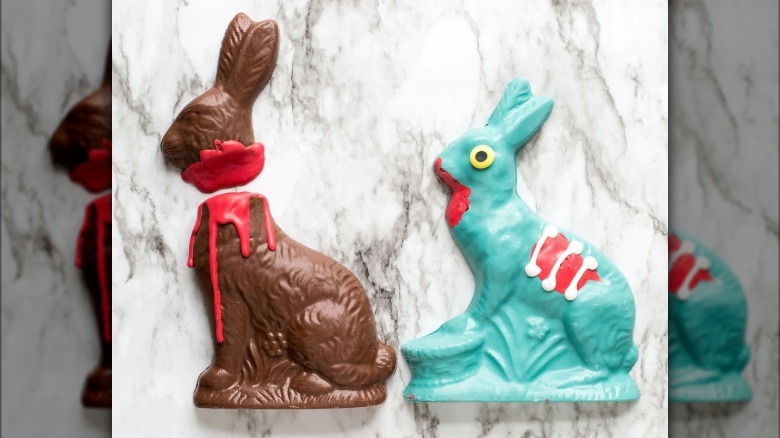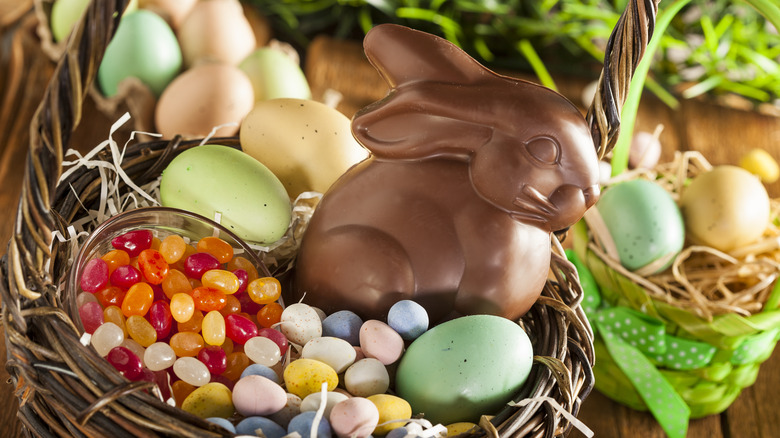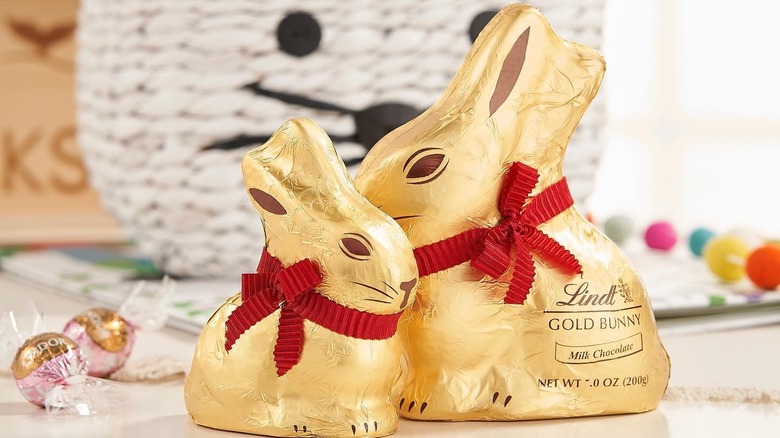The History Of Chocolate Bunnies
CORRECTION 3/7/23: A previous version of this article referred to Ben Strohecker as the owner of Harbor Sweets. Strohecker is the company's founder and former owner.
Easter tends to drum up visions of sacrifice, renewal, and joy. Plus, depending on your reason for celebrating, there are many different ways to observe this holiday. No matter how you mark the day, there's a good chance you do so with food, so when you think of Easter, plenty of food probably comes to mind. Perhaps your family dines on a beautifully glazed ham with plenty of savory sides. Or maybe you can only picture an Easter basket bursting at the seams with chocolate and candy. But no matter what you imagine, there's a good chance you also see one particular sweet item: a chocolate Easter bunny.
While these sweet treats are adorable and whimsical, much more history goes into making them than you might assume. It turns out, for example, that these delightful bunnies are not accidentally hollow. Instead, this is for a very specific purpose. What's more, they weren't always that way.
For many families, these bunnies symbolize the coming of spring and the joyful season of Easter. Though delicious chocolate bunnies have a lengthy ancestry, they remain popular today in classic and other more elaborate, expensive forms.
We can thank Germans for the Easter Bunny
It may be tempting to imagine that chocolate Easter bunnies are a recent invention, but these sweet treats are not new. It all starts with the Easter bunny. In the 19th century, people with German lineage invented the concept while living in either America or Germany. As a classic German myth goes, a little girl prayed to Eostra, a goddess of spring and the season of fertility. The little girl prayed for the revival of a bird that was struggling. This prayer turned the bird into a rabbit that would deliver colorful eggs, and the chocolate bunnies of today have roots back to this miracle bunny.
Beautifully designed eggs, on the other hand, are not as new. In fact, the act of creating lovely eggs is an old practice from about 60,000 years ago. But instead of chicken eggs, they were ostrich eggs. Today, children visit the Easter Bunny for photos and happily await Easter baskets. They also hunt down brightly colored eggs filled with candies, chocolate, trinkets, and sometimes pocket change. These traditions are similar to that of children of Germans who would create nests for the Oschter Haws (otherwise known as the Easter Hare) to visit and pile high with treats.
German traditions traveled to Pennsylvania
Thankfully, those German traditions didn't stay in Germany. In the 18th century, German immigrants, known today as Pennsylvania Dutch, brought the Oschter Haws traditions to the states along with their delicious chocolate.
But it was Robert L. Strohecker who requisitioned a giant Easter bunny to be made for his shopfront in Reading, Pennsylvania. His goal was to draw in business for the coming Easter season. The year was 1890, and the giant bunny earned him the nickname "Father of the Easter Bunny Business." Today, Harbor Sweets Chocolates of Massachusetts, which was founded by Robert's grandson Ben Strohecker, continues to sell smaller renditions of this large chocolate sculpture. Modern bunnies from Harbor Sweets come in dark chocolate and are only available in the time leading up to Easter. They come filled with caramel, pecans, almonds, and buttercrunch toffee, which is certainly a spin on the typical chocolate bunny.
Milk chocolate changed the game
When it comes to chocolate treats, nothing quite changes the game for chocolate bunnies more than the invention of milk chocolate. Throughout the 19th century, most people enjoyed chocolate as nothing more than a drink. J.S. Fry changed everything in 1847 when he created the first chocolate bar. This one was a mix of chocolate liquor, cocoa butter, and, perhaps most importantly, sugar. Then, the next giant leap came when Daniel Peter added dry milk powder in 1876. Chocolate bars advanced again when, in 1879, Rudolf Lindt created a machine that created chocolate that could be aerated, creating melty chocolates.
The R.E. Rodda Candy Co offered chocolate bunnies through catalog order in 1925, but these were not the first chocolate bunnies. In fact, German chocolate bunny molds from 1890 in Munich produced similar kinds of chocolate bunnies sold and packed in Easter baskets each year.
Today, you will find chocolate bunnies made from all sorts of chocolate. Lindt, for one, offers chocolate bunnies and milk chocolate, dark chocolate, white chocolate, and even milk chocolate hazelnut. Since many prefer the milky goodness of this smooth chocolate, it's no wonder that milk chocolate was one way the chocolate Easter Bunny gained popularity.
Personality arrived in the 1930s
For a time, perhaps it was enough for children to have Easter bunnies who simply looked the part. Occasionally, they had a bow around the neck to be extra dressed up for the holiday. But when those poses got a little boring, bunny personalities were introduced.
The Bortz Chocolate Company, founded in 1915, calls Reading, Pennsylvania home. Here, chocolate bunnies were produced on a large scale early on. Moreover, it was one of the first to give these bunnies a bit of life. In 1934, a bunny with true personality and talent appeared on shelves. This sweet little bunny appeared to be playing the accordion. Since then, the bunnies' skills have not stopped, and their abilities only continue to grow. Between music, sports, and a host of other hobbies, this bunny's interest holds no bounds.
Chocolate bunnies with personality also allow parents to customize their children's Easter baskets for their specific interests. Even still, we love a classic chocolate bunny. The fun, unique personalities are sweet, but there's just something so lovely about the original, classically posed bunny.
The bunnies are formed using molds
When you see a perfectly shaped chocolate bunny, it's hard to imagine how something so flawless yet so delicate and delicious could come to be. To create a perfectly formed bunny, chocolate companies pour hot, liquid chocolate into molds. Then, the chocolate inside the mold is jostled and shaken just enough to remove any remaining air bubbles that might form. This shaking also allows chocolatiers to create the perfect shell. If a company is large enough, it will have machines that do this process, but smaller confectioneries must do it carefully by hand.
Even home chefs can prepare their own chocolate bunnies with a little finesse. For this, you will need a chocolate bunny mold, chocolate of your choice, and some oil. The oil helps loosen up the chocolate to allow it to smoothly spread out into the mold. After melting down your chocolate and pouring it into the mold, you'll let it set until it fully hardens. To help loosen the bunny from the mold, go ahead and place it in the freezer for roughly 15 minutes to make the removal a bit easier. Then, you'll be able to remove your chocolate bunny and have the perfect accompaniment for any Easter basket. Plus, your homemade bunny will be solid, not hollow.
Hollow bunnies are easier to eat
If you've never enjoyed one, you might be slightly disappointed the first time you bite into a chocolate bunny. After all, most modern chocolate bunnies are actually hollow. Up until 1939, however, this wasn't the case. Before 1939, chocolate bunnies were solid chocolate all the way through. However, due to chocolate rationing during World War II, bakeries had to make sacrifices, and hollow chocolate bunnies helped them get there. The compromise here is that confectioners still got to create and sell their bunnies, but at the cost of less chocolate for the customer. This trend continues today because, more often than not, you will find a hollow bunny. There's actually a real reason for this, even if you feel like you are being jobbed out of some delicious chocolate.
The reason has everything to do with your teeth. Chocolate bunnies are somewhat on the thick side, and people generally struggle to eat a brick of chocolate that is over half an inch thick. Since most chocolate bunnies would be more than a half-inch, they need to be hollow to be enjoyed. And while solid chocolate bunny molds certainly exist, so do chocolate bunny molds that are hollow.
Bunnies were outlawed for a time
While producing hollowed-out bunnies certainly helps; eventually, even hollowed bunnies were not permissible. The War Production Board issued a conservation order in December of 1942 banning chocolate products representing many different items, including animals. The thought was that children could help their country by abstaining from enjoying holiday sweets, including the beloved chocolate bunny. This also helped build a sense of solidarity around those who were fighting the war.
This meant that during the Easters from 1944 to 1945, children often received bunnies made from other items like wax or soap in their baskets. This was also around the same time children started receiving stuffed rabbits instead of chocolate ones.
Even though children could not enjoy chocolatey bunnies, confectioners could certainly keep up their production efforts by providing sweet treats for those in the military. This helped boost morale and even provided a rich calorie snack for soldiers.
They can get expensive
Most of the chocolate bunnies you see on shelves and in Easter baskets are not terribly expensive, but there are some outrageously costly options out there. Though not available anymore, VeryFirstTo once sold a chocolate bunny from chocolatier Martin Chiffers that took two days to carve. It came in at 11 pounds and was made of Tanzanian chocolate, and its eyes sure glimmered because they were made of gold leaf and actual diamonds. The cost of this extravagant Easter Bunny rang in at $49,000.
Though expensive, VeryFirstTo didn't create the largest chocolate bunny. That distinction belongs to Senac-RS. This enormous rabbit came in at close to 8,500 pounds and was 13.5 feet tall. This chocolate bunny even required its own engineer to help ensure the rabbit was structurally sound.
Though you won't see such an Easter bunny gracing any Easter baskets anytime soon, the Chocolatician offers its own somewhat expensive option. The Chocolate Cumberbunny is the shape of Benedict Cumberbatch as if he were made into a rabbit. Though quite a bit less expensive than the most extravagant offering from VeryFirstTo, this one does come with a lovely luster dust to make it shine and sparkle.
Chocolate Easter bunnies remain popular today
When it comes to holiday traditions, the way they are passed down from family member to family member often means that they will persist for generations to come. In the case of bunny rabbits sold in chocolate form, this very well may be the case. After all, today, bunnies remain as popular as they ever have been. Each year, in the United States alone, 91 million chocolate bunnies show up in Easter baskets around the country. That number doesn't even include bunnies that are sold internationally. Since Americans spend over $1 billion each year on Easter candy in total, Easter is a more expensive candy holiday than other hard-hitting days like Christmas, Halloween, or even Valentine's Day. It's clear that even though Americans have their own religious or secular traditions surrounding this sweet day, a common thread may be gifting chocolate bunnies in elaborate baskets of sweets and gifts.
Most people go for the ears first
When it comes to eating a chocolate bar, people tend to have very particular opinions on how to eat their candy correctly. For example, if you've ever watched someone bite into a Kit Kat without breaking it into pieces first, you know the soul-crushing cringe this can induce. And chances are you also have your favorite side of the Twix bar. Of course, this specificity does not stop at chocolate bars. After all, most of us have opinions about how to properly eat an Oreo cookie. So how would you go about eating a chocolate bar that is shaped like an animal?
A study by Laryngoscope reports that a majority of chocolate bunny consumers start with the ears. Some people, on the other hand, go right for the feet, but this is a far less common approach. As it is, some care little about whether it is shaped like a rabbit or not. There are probably the same folks who bite into a whole Kit Kat without a care in the world. Even still, if you feel a little uncomfortable about going straight for the ears, try not to worry — most people are right there with you.
There are some pretty interesting variations
Between the ultra-expensive Easter bunny and the one shaped like Benedict Cumberbatch, it seems there are no limits on what other creative spin companies may put on the traditional chocolate bunny. Ikea, known for its DIY furniture assembly, once had a chocolate bunny you purchased in a flat box and assembled yourself, just like the company's furniture. This chocolate bunny was from the Vårkänsla line, and though it does not appear to be available anymore, the concept is just too creative to ignore.
For a completely original chocolate bunny, look no further than Sugar Plum Chocolates zombie bunny and victim chocolate bunnies. These rabbits come in unique colors with plenty of decoration to totally pull off the illusion that one of the bunnies has become a zombie and the other is, unfortunately, its victim. Starting with the ears is the least of your worries when it comes to these confections.
Gifting a chocolate bunny is better than the real thing
People tend to flock to animals around the holidays, especially when they are fluffy and cute. Unfortunately, a rabbit's fluffiness and adorable whiskers can put them in danger come Easter weekend. Well-meaning parents often think gifting their child a rabbit will be a sweet gift for the Easter season. However, these animals, like all pets, require much love and work. When the initial cuteness wares off, people sometimes make the destructive choice to abandon the rabbit at a shelter or even in the wild.
To help ward off this trend, it's much safer and helpful to gift a chocolate bunny instead of a live one. This choice will protect a bunny and help save you from the heartbreak of giving up a pet or, alternatively, 12 years of caring for a rabbit purchased for a surprise rather than as a family choice. Surprise pets rarely result in a happy balancing of efforts regarding chores and the animal's upkeep. All told, stick with chocolate bunnies and save the surprise for elsewhere.
Lindt made the bunnies gold
You may enjoy Lindt truffles, but its golden bunnies actually sparkle, and these bunnies are not just dressed up for the holiday; they actually have a sweet story to tell.
The golden Lindt chocolate bunny came about because a master chocolatier was having brunch with his family. During this meal, his young daughter spotted a bunny hopping about outside. The child asked if she could play with the bunny, and the chocolatier said yes. Of course, when the little girl went to look for the rabbit, it had hopped away, as bunnies will do. Seeing his daughter crestfallen, the chocolatier devised an inspired idea that children would love for generations. He created a bunny that she couldn't lose in the tall grass outdoors. That's why these bunnies are bright gold and feature a red ribbon with a bell on them.
Whether it's a legend or simply good branding, the golden bunnies have stuck. They quickly became quickly popular in Germany upon their introduction in 1952, although they took some time to cross borders. Swiss and Austrian children finally got their Golden bunnies in 1994, and in 1996, these glistening bunnies reached Great Britain and the United States.
